The 1960s opened with an abject reminder of the status of Wales for its nationalist minded subjects. The Tryweryn Campaign highlighted the failure of constitutional protest. As one of the last virtually monoglot Welsh communities, Capel Celyn came to symbolise both the pressure on the language and the apparent powerlessness of Welsh MPs to protect Welsh interests. Now Capel Celyn, the hamlet lies beneath the waters of Llyn Celyn – the Tryweryn reservoir – in Snowdonia.
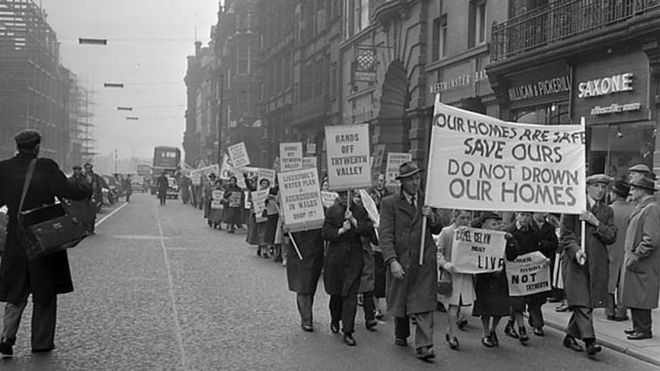
A contemporary view of the farther shores of politics and the state of Welsh nationalism in the mid-Sixties, saw American author George Thayer describe Plaid Cymru as divided into three ideological groups. The vast majority of Plaid members were characterised as pragmatists, the romantic Welsh nationalists compromised the smallest faction, while the revolutionaries were small in number and divided.
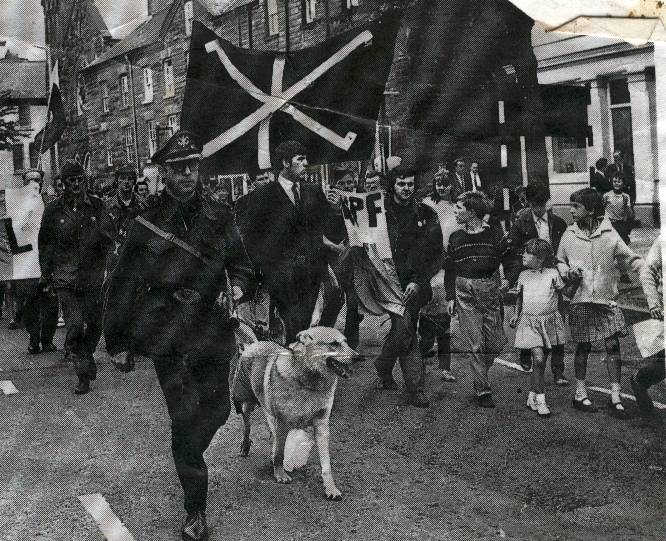
| FWA leader Julian Cayo Evans and “attack” dog, beloved Alsatian called Gelert |
Partly in response to the drowning of a valley, along with a Welsh-speaking village, so Liverpool Corporation could create a reservoir for the city’s water supply, the Free Wales Army (Fyddin Rhyddid Cymru), FWA, was formed in Lampeter, Mid-Wales in 1963, with the avowed objective of bringing about an independent Welsh republic. The FWA engaged in various publicity stunts and its leader Julian Cato Evans, and Dennis Coslett, otherwise Dafydd ap Coslett, self-styled commandant of the Carmarthenshire brigade, became a well-known media figures. The FWA paraded, boasting a full rank structure, uniform code, rank badges and decorations.
For all its militant posturing, the Free Wales Army, was presented in some sections of the media as a bunch of fantasy-fuelled dreamers pledged to “free Wales from the tyrannical English.”[1] John Humphries is scathing in his account of the FWA, [2] arguing the “threat it posed was almost entirely confined to newspaper headlines”. The FWA paraded with thirty-seven attending the Dublin march to mark the fiftieth anniversary of the Easter Rising. There were media coverage of the FWA on manoeuvres on Evans’s farm, “comedians …strutting their stuff around the Welsh countryside.” The organisation made extravagant boasts about its strength and firepower – claiming to have millionaire backers, its own aeroplane and links with the IRA and Basque separatists. In reality members never numbered more than 20 and even the gun in Coslett’s holster turned out to be a toy. Dressed in home-made uniforms, Coslett would also wear a black eye patch over his glass eye – the result of a mining accident. Television presenter David Frost once referred to him as Dai Dayan, because of his resemblance to Moshe Dayan, the Israeli general.
Clive Bloom thought of the FWA “for all their noise, too small, too weak and too well known to the police to be much trouble… Plaid Cymru had expelled the flag waving, uniformed nationalists from its ranks.”[3]
The Labour Party’s Secretary for Wales, George Thomas (future Speaker of the House) thought the attacks around the Investure as nothing less that political terrorism encourages by Plaid Cymru after it had failed to stop Tryweryn, accusing it of having created a monster it could not control. Humphries records Plaid’s leadership as repudiating the allegations that the party had consorted with extremists, adding, ‘Plaid Cymru has condemned without reservation these outrages.’[4]
One of the journalists who provided access for Evans, freelancer John Summers, was simultaneously secretly informing the Regional Crime Squad, based in Bristol, on the activities of the FWA. Humphries speculates that the “the only reason the FWA was not rounded up sooner was because the police genuinely considered the army harmless. The only other explanation was that the FWA ‘soldiers’ were allowed to strut their stuff in the hope they might help in the detection of the real bombers.”[5]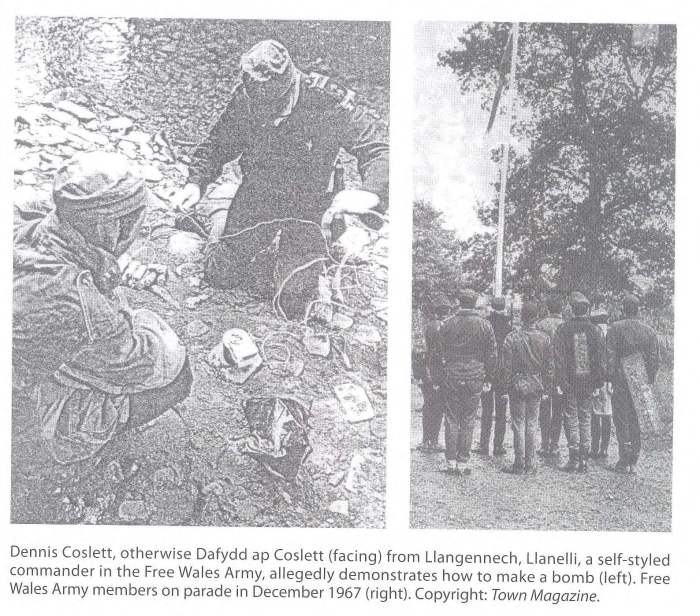
There was little chance of that as John Jenkins, as Director of Operations had reorganised Mudiad Amddiffyn Cymru (that had emerged during the struggle over Tryweryn) on a cell structure and maintained a clandestine existence well away from the publicity-hungry FWA.
The summer of ’69 up on the walls went the slogan “Llewelyn lives,” to go with badges proclaiming “No Englishman is Prince of Wales”, the title that belonged only to Llewelyn ap Gruffuyd, the last true Prince of Wales, killed in 1282.
The opposition to the ceremonial at Caernarfon Castle was expressed in two distinct campaigns: the protests organised by the Anti-Investiture Campaign Committee were identified with republicans and the struggle for independence; Plaid Cymru and Cymdeithas yr laith Gymraeg saw the protests as an opportunity to relauch the language campaign. Whatever the strength of opposition to the decision to make Charles, Prince of Wales it did not warrant media investigation – why spoil the party when all opposition was quarantined as belonging to the lunatic fringe.
The FWA’s rhetoric grew ever more fantastical; FWA called upon all Welshmen to arm themselves “with guns, bombs, Molotov cocktails, grenades, pikes, bows and arrows, swords, bayonets, clubs, eggs filled with acid, sharpened pennies, then take them to Caernarvon, seize the castle at dawn, the flag of free Wales must fly that day.”
February 26, 1969, the police arrested nine FWA members in dawn raids. At the start of the trial in Swansea in May 1969, the defendants were greeted with an impromptu recital of Land of My Fathers from the public gallery. Coslett refused to speak in English throughout the 53 day hearing.
The trial ended fortuitously on the day of the Investiture. The Queen crowned her son, Prince Charles, as Prince of Wales during the investiture ceremony at Caernarfon Castle on July 1, 1969. Cayo and his number two, Dennis Coslett, were jailed for 15 months for public order offences.
Coslett insisted to a journalist:
“Five years ago you’d never hear a Welshman talking about nationalism but as soon as these explosions occurred the people bloody well began to talk and you can bloody well go into any pub in Wales today and you will always hear people talking about our own government, you will always hear someone arguing.”[6]
From the moment of the first bomb at Clywedog, the political knee-jerk reaction was always the same: expression of outrage, followed by the determination of the political class to dissociate mainstream Welsh opinion from nationalist activists. They refused to countenance the possibility that there existed an undercurrent of admiration and convert support for the insurgents at ‘war’ with England.[7]
A question to consider is to what extent the direct action of the Sixties’ picked up again by the holiday home arsonists a decade later, helped promote a national consciousness and shape a political environment in which the governing class became more receptive to Welsh aspirations up to the establishment of the Welsh Assembly . Plaid Cmyru has condemned law breaking and thought that it has electorally suffered when regarded as associated with the actions of such fringe groups.
Roy Clews’ “To Dream of Freedom: the struggle of M.A.C. and the Free Wales Army “[8] presents a more rounded picture of the groups. Maybe over-romanticised when portrayed as a challenge England’s rule in the first Welsh armed rebellion since the days of Owain Glynd, there was a sabotage campaign against dams and power installions. From its inception in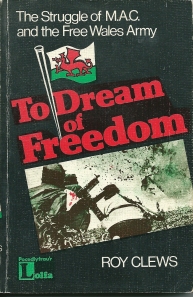 1963, the two main protagonists of Mudiad Amddiffyn Cymru (MAC), the Movement for the Defence of Wales, Owen Williams and John Jenkins, were responsible inspiring the Sixties’ sabotage campaign directed at water pipelines, Government offices and the Prince of Wales.
1963, the two main protagonists of Mudiad Amddiffyn Cymru (MAC), the Movement for the Defence of Wales, Owen Williams and John Jenkins, were responsible inspiring the Sixties’ sabotage campaign directed at water pipelines, Government offices and the Prince of Wales.
The Movement for the Defence of Wales / Mudiad Amddiffyn Cmyru (MAC) under John Jenkins organising a series of explosions that made Welsh patriotism on the extremist fringes a serious threat. Each explosion was directed at property and disruption, this was no campaign of murderous intent. In a BBC2 interview shown on 4 July 2009, John Jenkins repeated his assertion that the bombs were never planted nor timed to hurt people but just to disrupt the ceremony. Those who did die were MAC activists on 30 June 1969, the evening before the investiture, two members of MAC, Alwyn Jones and George Taylor, were killed in a premature explosion when a bomb they had been intending to place outside Government offices in Abergele exploded. In November 1969, following a tip-off, John Jenkins was arrested.
John Jenkins – Welsh Terrorist – Copy
“To reawaken the national consciousness of the Welsh people by propaganda and by action with explosives…” John Jenkins |MAC Director of Operations | from witness statements at his trial.
MAC’s activities ceased when John Jenkins was convicted of eight offences involving explosives in April 1970 and sentenced to ten years. While at Albany prison on the Isle of Wight, he underwent a 40 days hunger strike protesting against conditions in the prison. Jenkins’ Prison Letters , edited by Rhodri Williams , was published by Y Lolfa in 1981.
The letters themselves provide an interesting insight into the life of a political prisoner as well as revealing some of his ideological and philosophical values.
The petty treatment and isolation of Jenkins at Albany as category A prisoner is explored in Humphries study “Freedom Fighters” who draws a not unfavourable picture of Jenkins character and actions; Jenkins changed his plea at trial on eight accounts:
This was the man who elected to go to jail rather than risk revealing the identities of his accomplices[9]
Jenkins was a model inmate – singing in the prison choir; learning Welsh; and creating Celto-Christian works of art. He started an Open University degree in Social Sciences that was completed after his release.
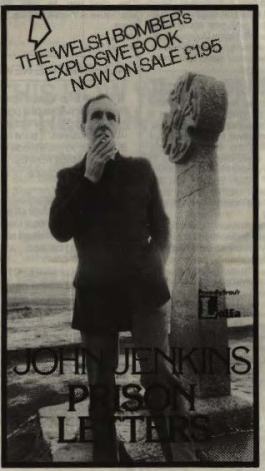 “When he was imprisoned few people were concerned about his political beliefs but since then a cult has developed around him. He has become the first martyr of the political idea that as long Cymru is not free violence against property is justified.” [10]
“When he was imprisoned few people were concerned about his political beliefs but since then a cult has developed around him. He has become the first martyr of the political idea that as long Cymru is not free violence against property is justified.” [10]
Upon release, Jenkins remained active in the socialist republican scene concentrating on the activities of the ‘Welsh Martyrs Fife & Drum Band’ but was still seen by the authorities as a “usual suspect” so later figured in the WSRM Conspiracy trial where sentenced for two years once more for assisting Dafydd Ladd to avoid arrest. Jenkins’ views had not mellowed with age.
[1] Journalistic view expressed by Dan O’Neill, Bombers urged to rise up to protect the Welsh homeland in the summer of ’69. http://www.walesonline.co.uk/lifestyle/nostalgia/bombers-urged-rise-up-protect-7345912
[2] Humphries, John (2008) “Freedom Fighters: Wales’s Forgotten ‘War’. 1963-1993. University of Wales Press:45
[3] Bloom (2007) Terror Within: Terrorism and the Dream of a British Republic. Sutton Publishing: 261
[4] Humphries (2008) 110
[5] Humphries (2008):56
[6] Quoted in Humphries (2008):55
[7] Humphries (2008) 111
[8] Clews, Roy (1980) To Dream of Freedom: the struggle of M.A.C. and the Free Wales Army: Talybont, Wales : Y Lolfa
[9] Humphries (2008) 144
[10] Carn No.12 1976. See also: Jenkins, John (1981) Prison Letters. Y Lolfa, Talybont, Wales